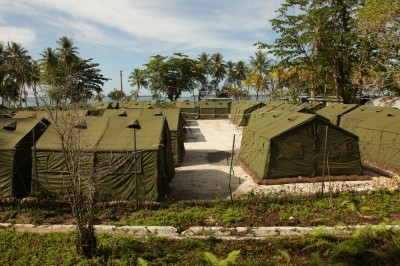Australia and the Asylum Seekers: The Hideous Manus Island Camp, Institutionalized Cruelty, “The Nauru Files”

When the first reports came through about the unfolding Holocaust during the Second World War, audiences were incredulous. Surely no industrialised society could quite go so far? Killings, yes; butcheries, certainly. But a mass-scale industrialised gassing and massacring of whole populations was simply not tenable. The same treatment could be said in the context of the gulag system and Stalinist purges.
The scale of such killings, the inventive lengths of such cruelties, were not believable. The dooms dayers were dismissed as inventive cranks. They were the troublemakers whose words were taken with the most generous pinch of salt.
The only credible technique in dealing with such denialist claims would be pictures and snapped images; a relentless string of numbing images that would enable the individual to take stock, to process and even to catalogue the horrors on a mental map.
US General Dwight D. Eisenhower was one such figure cognisant of the power of the image. Visits were made to an assortment of German concentration camps, with the general insisting that he would also be in the grisly snaps.
The visit to the Ohrdruf subcamp of Buchenwald on April 12, 1945, in the company of Generals George S. Patton and Omar Bradley, shook him. General George C. Marshall, then head of the Joint Chiefs of Staff in Washington, received a cable after that visit about the “visual evidence and the verbal testimony of starvation, cruelty and bestiality” that proved “so overpowering as to leave me a bit sick.”[1]
Members of the US Army Signal Corps recorded some 80,000 feet of moving film and still photographs, processing 6,000 feet of that material in what became the one-hour documentary Nazi Concentration Camp. It would be used, with some prosecutorial effect, at the Nuremberg War Crimes trials.
Instances of memorialised, even spectacular cruelty, are matters for the modern, social networked citizen. Text is only a poor substitute for the image: the image of drowned Syrian child Alan Kurdi always says more in its spell binding terror than a description released from an asylum seeker in a processing centre. Bureaucrats, as they always do, kill personality in favour of systems and paper clips.
Reacting to cruelty, broadly speaking, has various mechanisms. In the absence of images coming out of Nauru on the mistreatment of asylum seekers and refugees, disbelief and justification are twinned answers. Together, they form apologias of the establishment, one that insists that regional camps are appropriate over Australian community centres; where humans are treated as unclean defectives who need to be processed into order to be rendered pure.
The processing motif here is important: wrapped in the deceptive plastic of dignity and legitimacy, compliant with the laws of a country, the human arrivals will be assessed. But if found to be refugees, they will be refused entry into Australia.
Distant, not merely spatially but emotionally, the refugees and asylum seekers in the Australian context assume invisible forms. Their humanity is irrelevant, and even more strikingly, deniable. What matters is that they are processed in detention centres from afar. Money and guards are supplied to man the camps in a privatised capacity by Canberra, whose politicians insist on the falsehood that control over such camps is an entirely sovereign matter.
Tactics to undermine, discredit and sanitise the hideousness of the camp system are also used with propagandistic dedication. In the wake of the release of the “Nauru Files” by The Guardian, documenting the assortment of abuses taking place on the island, the Department of Immigration and Border Protection was immediately at hand with desensitising advice.
“The documents published today,” went the mopping press release of August 10, “are evidence of the rigorous reporting procedures that are in place in the regional processing centre – procedures under which any alleged incident must be recorded, reported and where necessary investigated.”[2]
A deft reversal was suggested: that such matters were reported was evidence of professionalism and efficiency, not institutionalised, intolerable cruelty. Besides, came the executing backhand, “Many of the incident reports reflect unconfirmed allegations or uncorroborated statements and claims – they are not statements of proven fact.”
While it would be a stretch to claim that the Nauru Regional Processing Centre, or the soon to be closed Manus Island facility, be classed as concentration camps par excellence, they are very much centres of ritualised and applied cruelties, shielded by regulations and silence.
The only testimonies that have shattered such smug layers of secrecy have come from whistleblowers, former camp guards, and employees connected with the camp system. One such figure was Tracey Donehue, a teacher at the Nauru centre until November 2015.
Her question broadcast on the ABC’s Q&A program potentially breached the secrecy provisions of the Australian Border Force Protection Act in noting the “appalling treatment” of rape victims and injuries inflicted by “people in the community.”[3]
Again, images have greater truck in an environment of interpretation emptied of imagination. That much can be gathered by the limits placed on Australia’s politicians in visiting those camps, a striking and chilling contrast to the reality jolt insisted upon by Eisenhower in 1945 on arranging editors and “a dozen leaders of Congress” to visit the liberated sites.
Any medium or means that would humanise the asylum seeker and refugee, be it by sight or by document, continues to be religiously and studiously avoided. Besides, alleges immigration minister Peter Dutton, “some people do have a motivation to make a false complaint.”
The Nauru government obsequiously agrees with this theory of natural mendacity: “Most refugee & advocate claims on Nauru fabricated to achieve goal to get to Aust.[sic].”[4] Denialism and repudiation of the human spirit remain cold and damnable companions.
Dr. Binoy Kampmark was a Commonwealth Scholar at Selwyn College, Cambridge. He lectures at RMIT University, Melbourne. Email: [email protected]
Notes
[1] https://www.ushmm.org/wlc/en/
[2] http://newsroom.border.gov.au/
[3] http://www.abc.net.au/news/
[4] http://www.abc.net.au/news/

